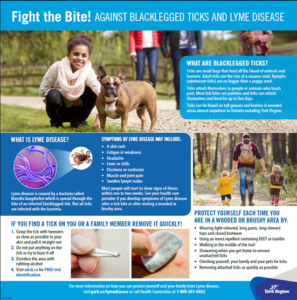Tick Awareness
With the arrival of warmer weather, we are spending more time outdoors, which can increase the risk of blacklegged tick bites and Lyme disease.
Ticks are small and difficult to see and can range in size from a poppy seed to a pea depending on their life stage (larva, nymph, adult). Ticks cannot jump or fly. When a person or animal brushes by vegetation (such as tall grass or bushes along a forest trail) that the tick is resting on, the tick climbs onto the person or animal in search of a place to bite and feed (exposed skin).
Blacklegged ticks can be found almost anywhere outdoors, but they are most often found in tall grasses, bushes/shrubs, wooded and forested areas. Ticks are most active in the spring, summer and fall when the temperature is above freezing.
Lyme disease is an illness spread through the bite of a blacklegged tick that is infected with the Borrelia burgdorferi bacteria. Not all ticks are infected with the bacteria, so not all tick bites spread Lyme disease. Lyme disease does not spread from person to person.
Symptoms of Lyme disease can appear within one to two weeks after a bite from an infected blacklegged tick. These may include a skin rash (e.g. circular, red rash which may look like a ‘bull’s-eye’ but the appearance of the rash may vary), fatigue or weakness, headache, fever or chills, dizziness or confusion, muscle and joint pain, and/or swollen lymph nodes. If you develop symptoms of Lyme disease, consult your health care provider. If you find a tick, remove it from the body as quickly and carefully as possible.
Prevention of Tick Bites
-
Wear light coloured clothing, long pants, long sleeved tops, socks and closed-toe footwear
-
Use insect repellent containing DEET or icaridin
-
In wooded areas or areas of brush and parks, stay on paths (middle of the trail)
-
After being outdoors, search your body for ticks especially in the following areas: behind your knees, on your head, belly button, underarm areas, groin, and back
-
Shower when you get home to remove unattached ticks
-
Check yourself, your family and your pets for ticks
Tick Removal – Students
If a student is found with a tick, it will need to be removed as soon as possible.
-
Contact and inform the parent/guardian
-
Advise them to pick up the student to have the tick removed as soon as possible as removing a tick within 24 to 36 hours of it starting to feed is likely to prevent Lyme disease.
-
York Region’s fact sheet [pdf-embedder url=”https://saa.ycdsb.ca/wp-content/uploads/sites/46/2025/05/Lyme-Disease-Fight-the-Bite.pdf”
More information is available by contacting York Region Health Connection at 1-800-361-5653 or at www.york.ca/lymedisease.

